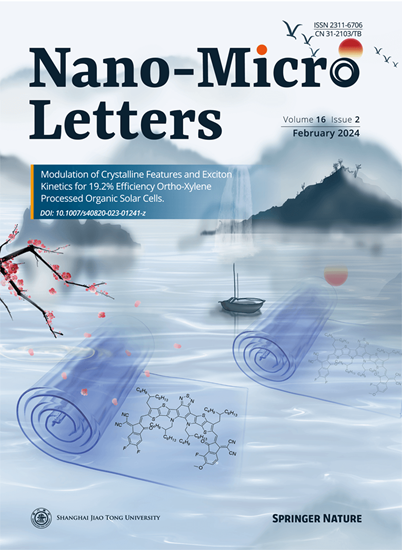利用合理掺杂调制缺陷工程实现无铅压电陶瓷的高温能量收集
IF 36.3
1区 材料科学
Q1 Engineering
引用次数: 0
摘要
高温压电能量收集器(HT-PEH)是替代化学电池实现高温无线传感器独立供电的重要解决方案。然而,无铅压电陶瓷必须同时具有优异的性能,包括高优点系数(FOM)、绝缘电阻率(ρ)和去极化温度(Td),但这很难实现,尤其是在 250 °C 下工作的无铅压电陶瓷更是如此。在这里,通过创新的缺陷工程和精细的锰掺杂,BiFeO3-BaTiO3 陶瓷实现了良好的平衡性能。由于极化构型优化提高了电致伸缩系数,高价锰离子调节了铁离子氧化态,缺陷偶极稳定了畴取向,这些协同作用在锰离子的固溶极限下实现了全面优异的电性能(Td = 340 ℃,ρ250 ℃ > 107 Ω cm,FOM250 ℃ = 4905 × 10-15 m2 N-1)。利用合理设计的压电陶瓷组装的 HT-PEH 可在 250 ℃ 下对商用电解电容器进行快速充电,并具有较高的能量转换效率(η = 11.43%)。这些特性表明,缺陷工程定制的 BF-BT 可以满足高端 HT-PEHs 的要求,为开发在高温环境下工作的自供电无线传感器铺平了新的道路。本文章由计算机程序翻译,如有差异,请以英文原文为准。

Defect Engineering with Rational Dopants Modulation for High-Temperature Energy Harvesting in Lead-Free Piezoceramics
Highlights
-
The solution limit of manganese ion in BiFeO3–BaTiO3 (BF–BT) was determined by combining multiple advanced characterization methods.
-
The defect engineering associated with fine doping can realize the co-modulation of polarization configuration, iron oxidation state and domain orientation.
-
The BF–BT–0.2Mn piezoelectric energy harvester shows excellent power generation capacity at 250 °C, which is an important breakthrough for lead-free piezoelectric devices.
求助全文
通过发布文献求助,成功后即可免费获取论文全文。
去求助
来源期刊

Nano-Micro Letters
NANOSCIENCE & NANOTECHNOLOGY-MATERIALS SCIENCE, MULTIDISCIPLINARY
CiteScore
32.60
自引率
4.90%
发文量
981
审稿时长
1.1 months
期刊介绍:
Nano-Micro Letters is a peer-reviewed, international, interdisciplinary, and open-access journal published under the SpringerOpen brand.
Nano-Micro Letters focuses on the science, experiments, engineering, technologies, and applications of nano- or microscale structures and systems in various fields such as physics, chemistry, biology, material science, and pharmacy.It also explores the expanding interfaces between these fields.
Nano-Micro Letters particularly emphasizes the bottom-up approach in the length scale from nano to micro. This approach is crucial for achieving industrial applications in nanotechnology, as it involves the assembly, modification, and control of nanostructures on a microscale.
 求助内容:
求助内容: 应助结果提醒方式:
应助结果提醒方式:


